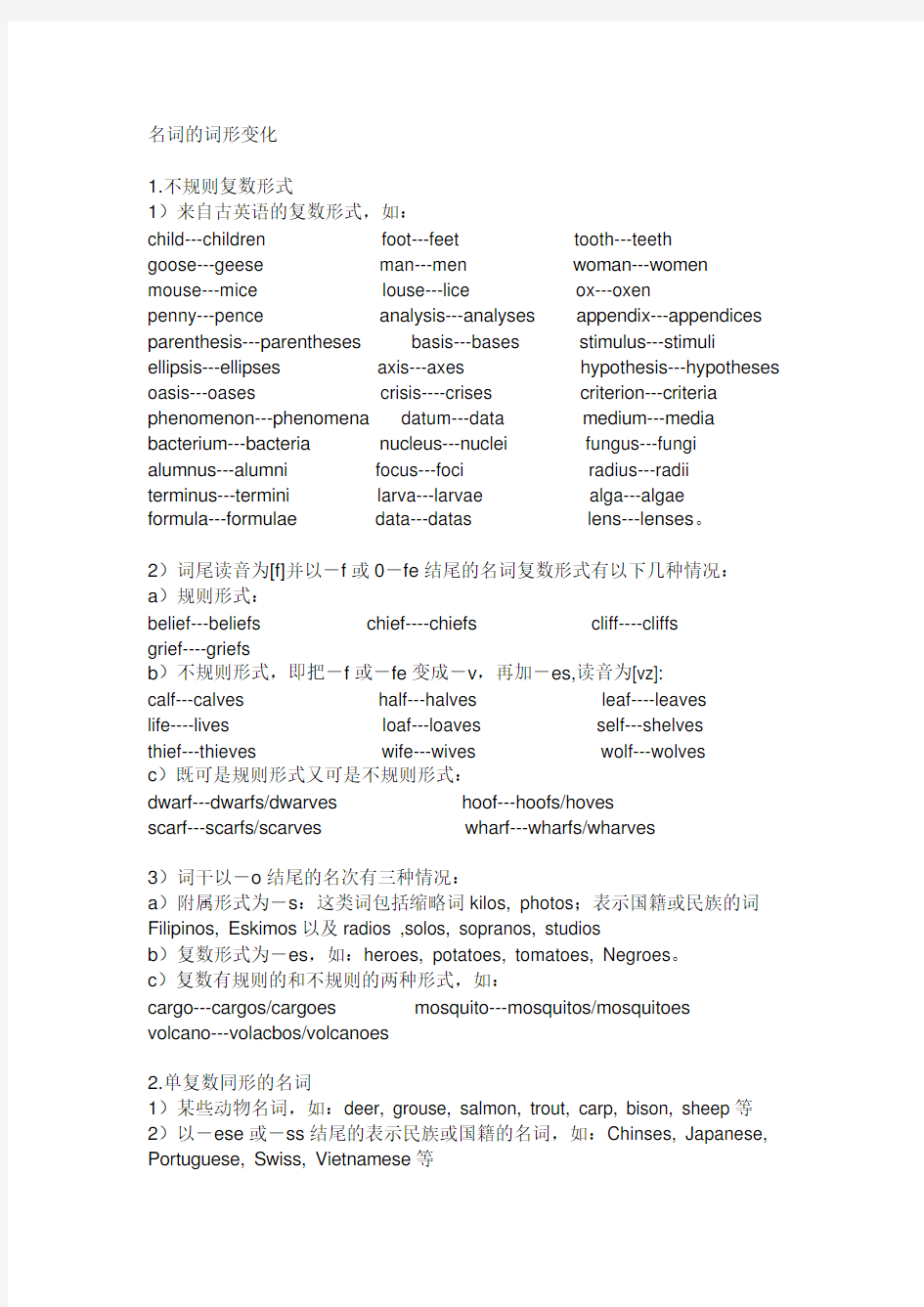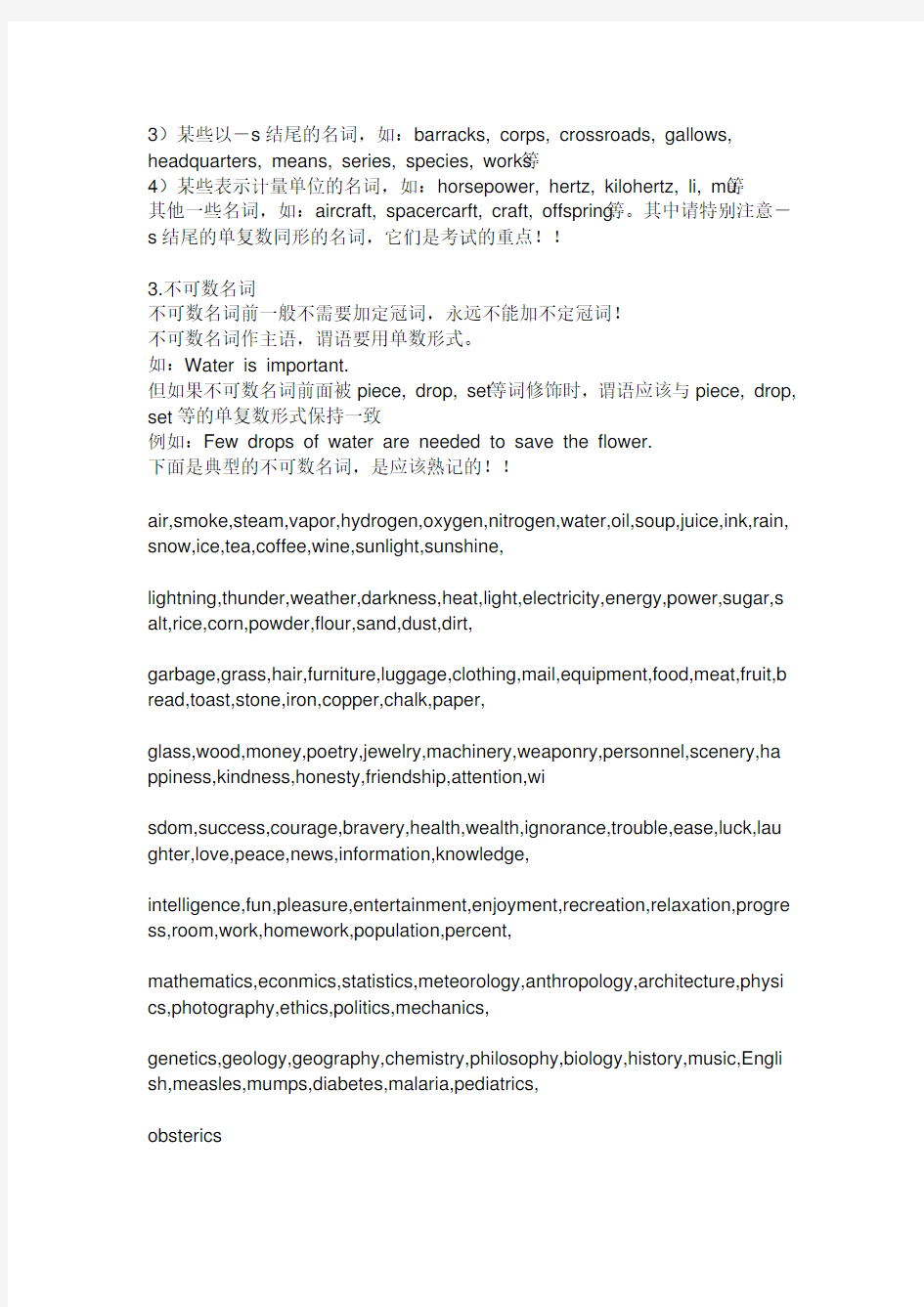(完整版)特殊名词变复数


名词的词形变化
1.不规则复数形式
1)来自古英语的复数形式,如:
child---children foot---feet tooth---teeth
goose---geese man---men woman---women
mouse---mice louse---lice ox---oxen
penny---pence analysis---analyses appendix---appendices parenthesis---parentheses basis---bases stimulus---stimuli ellipsis---ellipses axis---axes hypothesis---hypotheses oasis---oases crisis----crises criterion---criteria phenomenon---phenomena datum---data medium---media bacterium---bacteria nucleus---nuclei fungus---fungi alumnus---alumni focus---foci radius---radii
terminus---termini larva---larvae alga---algae
formula---formulae data---datas lens---lenses。
2)词尾读音为[f]并以-f或0-fe结尾的名词复数形式有以下几种情况:
a)规则形式:
belief---beliefs chief----chiefs cliff----cliffs
grief----griefs
b)不规则形式,即把-f或-fe变成-v,再加-es,读音为[vz]:
calf---calves half---halves leaf----leaves
life----lives loaf---loaves self---shelves
thief---thieves wife---wives wolf---wolves
c)既可是规则形式又可是不规则形式:
dwarf---dwarfs/dwarves hoof---hoofs/hoves
scarf---scarfs/scarves wharf---wharfs/wharves
3)词干以-o结尾的名次有三种情况:
a)附属形式为-s:这类词包括缩略词kilos, photos;表示国籍或民族的词Filipinos, Eskimos以及radios ,solos, sopranos, studios
b)复数形式为-es,如:heroes, potatoes, tomatoes, Negroes。
c)复数有规则的和不规则的两种形式,如:
cargo---cargos/cargoes mosquito---mosquitos/mosquitoes
volcano---volacbos/volcanoes
2.单复数同形的名词
1)某些动物名词,如:deer, grouse, salmon, trout, carp, bison, sheep等
2)以-ese或-ss结尾的表示民族或国籍的名词,如:Chinses, Japanese, Portuguese, Swiss, Vietnamese等
3)某些以-s结尾的名词,如:barracks, corps, crossroads, gallows, headquarters, means, series, species, works等
4)某些表示计量单位的名词,如:horsepower, hertz, kilohertz, li, mu等
其他一些名词,如:aircraft, spacercarft, craft, offspring等。其中请特别注意-s结尾的单复数同形的名词,它们是考试的重点!!
3.不可数名词
不可数名词前一般不需要加定冠词,永远不能加不定冠词!
不可数名词作主语,谓语要用单数形式。
如:Water is important.
但如果不可数名词前面被piece, drop, set等词修饰时,谓语应该与piece, drop, set等的单复数形式保持一致
例如:Few drops of water are needed to save the flower.
下面是典型的不可数名词,是应该熟记的!!
air,smoke,steam,vapor,hydrogen,oxygen,nitrogen,water,oil,soup,juice,ink,rain, snow,ice,tea,coffee,wine,sunlight,sunshine,
lightning,thunder,weather,darkness,heat,light,electricity,energy,power,sugar,s alt,rice,corn,powder,flour,sand,dust,dirt,
garbage,grass,hair,furniture,luggage,clothing,mail,equipment,food,meat,fruit,b read,toast,stone,iron,copper,chalk,paper,
glass,wood,money,poetry,jewelry,machinery,weaponry,personnel,scenery,ha ppiness,kindness,honesty,friendship,attention,wi
sdom,success,courage,bravery,health,wealth,ignorance,trouble,ease,luck,lau ghter,love,peace,news,information,knowledge,
intelligence,fun,pleasure,entertainment,enjoyment,recreation,relaxation,progre ss,room,work,homework,population,percent,
mathematics,econmics,statistics,meteorology,anthropology,architecture,physi cs,photography,ethics,politics,mechanics,
genetics,geology,geography,chemistry,philosophy,biology,history,music,Engli sh,measles,mumps,diabetes,malaria,pediatrics,
obsterics
(完整版)特殊名词变复数
名词的词形变化 1.不规则复数形式 1)来自古英语的复数形式,如: child---children foot---feet tooth---teeth goose---geese man---men woman---women mouse---mice louse---lice ox---oxen penny---pence analysis---analyses appendix---appendices parenthesis---parentheses basis---bases stimulus---stimuli ellipsis---ellipses axis---axes hypothesis---hypotheses oasis---oases crisis----crises criterion---criteria phenomenon---phenomena datum---data medium---media bacterium---bacteria nucleus---nuclei fungus---fungi alumnus---alumni focus---foci radius---radii terminus---termini larva---larvae alga---algae formula---formulae data---datas lens---lenses。 2)词尾读音为[f]并以-f或0-fe结尾的名词复数形式有以下几种情况: a)规则形式: belief---beliefs chief----chiefs cliff----cliffs grief----griefs b)不规则形式,即把-f或-fe变成-v,再加-es,读音为[vz]: calf---calves half---halves leaf----leaves life----lives loaf---loaves self---shelves thief---thieves wife---wives wolf---wolves c)既可是规则形式又可是不规则形式: dwarf---dwarfs/dwarves hoof---hoofs/hoves scarf---scarfs/scarves wharf---wharfs/wharves 3)词干以-o结尾的名次有三种情况: a)附属形式为-s:这类词包括缩略词kilos, photos;表示国籍或民族的词Filipinos, Eskimos以及radios ,solos, sopranos, studios b)复数形式为-es,如:heroes, potatoes, tomatoes, Negroes。 c)复数有规则的和不规则的两种形式,如: cargo---cargos/cargoes mosquito---mosquitos/mosquitoes volcano---volacbos/volcanoes 2.单复数同形的名词 1)某些动物名词,如:deer, grouse, salmon, trout, carp, bison, sheep等 2)以-ese或-ss结尾的表示民族或国籍的名词,如:Chinses, Japanese, Portuguese, Swiss, Vietnamese等
名词的复数与动词单三形式的区别
名词的复数形式与动词第三人称单数形式的区别 这段时间,在讲解第三人称单数形式时,我常常跟学生提到,这段时间,在讲解第三人称单数形式时,我常常跟学生提到,第三人称单数形式的变化规律一般跟复数一般变化规律相似,基本情况下加-s.但是一次课堂上我问到,动词以- ch结尾时,它的第三人称单数是什么,不少同学回答是加-es我又让他们举个例子,有学生给我举了:peaches,我突然间觉得,教学中有失误,学生将名词的复数形式和动词的第三人称单数形式混淆了。既然提到,就有必要跟学生讲清楚,帮助他们做一个比较。 首先,我帮助他们理解了两种不同的词性。为什么叫复数?显然是不只一个。什么东西可以一个一个地数呢?物品类。物品通常指名词,所以,我告诉学生:复数是属于名词的。而动词第三人称单数形式,顾名思义是属于动词的。什么是动词,就是有动态的意思的,包括外在变化和心里变化的。明白了他们各自的所属性,再对这两种变化规律作一个比较。名词复数形式和动词第三人称单数形式性质上截然不同,但它们在构成方式上有异也有同。试比较如下: 一、构成方式的相同点 1.两者一般在词尾加-s 清辅音后读作,浊辅音和元音后读作[z]。 如:名词复数:bed(beds), tree(trees), 动词第三称单数:help(helps), play(plays) 2.两者以s ,x ,ch ,sh 结尾的词,在词尾加-es,原词尾已有e,一般只加-s 都读作[iz] [iz]。 如:名词复数:box(boxes), orange(oranges) 动词第三人称单数:wash(washes), close(closes) 3.以辅音字母加-y 结尾的词,先变y 为i,再加-es,读作[iz]。 如:名词复数:factory(factories), baby(babies) 动词第三人称单数:fly(flies), study(studies) 二、构成方式的不同点 1.名词方面 (1)有些名词的单、复数形式相同。 如:sheep(sheep), Chinese(Chinese) (2)有些名词的复数形式是特殊的,不规则的。 如:man(men),child(children) (3)以o 结尾的名词,有的加s,也有的加es。 如:radio(radios), photo(photos),tomato(tomatoes) (4)以fe 结尾的先变f(e)为v,再加es。 如:knife(knives),leaf(leaves) 2.第三人称单数形式方面 (1)以o 结尾的动词加es。如:go(goes), do(does) (2)不规则的。如:be-is,have(has) 【※内容链接】哪些主语是第三人称单数? 1.人称代词he,she, it. He likes watching TV. 2.单个人名、地名作主语,比如Ken,Shenzhen Ken runs fast. Shenzhen is a big city 3. 单数可数名词,比如:A horse, A cat
英语名词改复数的方法
名词复数变化规则和读音: 1.一般在名词的词尾加“s”,清辅音后读/s/ 浊辅音和元音后读/z/ 例如:books, pens, classrooms,map-maps,boy-boys,girl-girls,pen-pens等等。cats 猫rooms 房间horses 马trees 树roses 玫瑰 2.以s, x, sh, ch结尾的名词在词尾加“es”,读/iz/ 例如:classes, boxes, brushes, dishes, watches, buses,classes,foxes ,lashes 鞭子,pushes 推力,branches 树枝、分支,matches 火柴、比赛,coaches 教练,gases 气体,asses 驴子但也有例外,如:stomach—stomachs等等。 3.以辅音字母加“y”结尾的名词应改“y”为“i”,再加“es”,读/z/ 例如:cities, universities),factories,baby---babies,city-cities,country-countries,families 家庭,ponies 小马 但以y结尾的专有名词,或元音字母+y 结尾的名词变复数时,直接加s变复数。 例如:two Marys,the Henrys,monkey---monkeys,holiday---holidays,boys, toys 4.以“f”和“fe”结尾的名词应改“f”和“fe”为“ves” 例如:shelf—shelves架子,knife—knives,leaf---leaves叶,wolf---wolves狼,wife---wives 妻子life---lives,thief---thieves小偷,calf---calves 小牛,half---halves 一半但也有例外 如:roof—roofs屋顶,cliff—cliffs(悬崖),hoof—hoofs(马蹄),belief—beliefs(信仰),chief—chiefs(首领),proof—proofs(证明),safe—safes(保险箱),reef—reefs(礁),gulf---gulfs 海湾 还有一些该类名词的复数形式有两种变化形式的 例如:scarf—scarfs/scarves(头巾), dwarf—dwarfs/dwarves(矮子), wharf—wharfs/wharves(码头), handkerchief—handkerchiefs/handkerchieves(手帕)等等。 5.以“o”结尾的名词的复数形式一般在词尾加“es” 例如:hero—heroes英语, echo—echoes(回音),potato—potatoes马铃薯,tomato—tomatoes西红柿,mango---mangoes 芒果,volcano---volcanoes 火山,negro---negroes 黑人, cargo---cargoes 货物,buffalo---buffaloes 水牛,mosquito---mosquitoes 蚊子 但以字母o结尾的外来词或缩写词的复数形式是只加S, 例如:zoo—zoos, radio—radios, piano—pianos钢琴, photo—photos, memo—memos(备忘录), solo—solos(独唱、独奏), kilo—kilos(公斤),kimono—kimonos(和服),bamboo---bamboos 竹子,kangaroo---kangaroos 袋鼠,mulatto---mulattos 白黑混血儿, 6. 如果名词结尾是一个元音(即a,e,i,o,u) 加y,那只则在单数词后加一个s就行了。 play plays 戏剧 way ways 小路 valley valleys 山谷 donkey donkeys 驴
名词的单复数形式
一、名词的单复数形式 英语可数名词有单数和复数两种形式。复数名词的变化有规则变化和不规则变化两种。 1、规则变化 名词复数的构成,通常是在单数形式后面加-s或-es,其方法如下:构成法例 一般情况在词尾加-s shop-shops desk-desks 以s、x、sh、ch结尾的词在词尾加-es bus-buses box-boxes watch-watches brush-brushes 以ce se ze (d)ge等结尾的词直接加-es face-faces house-houses page-pages 以辅音字母+y结尾的词,y变成i加-es baby-babies city-citise factory-factories story-stories 以“辅音字母+o”结尾的词,多数在词尾加-es tomato-tomatoes hero-heroes Negro-Negroes \以“元音字母+o”结尾的词和某些以o结radio-radios photo-photos 尾的外来词,加-s piano-pianos zoo-zoos 以f或fe结尾的词,多数变f或fe为v加life-lives knife-knives -es,少数不变,只在词尾加-s wife-wives roof-roofs 2、不规则变化 (1)名词复数的特殊形式 man-men,woman-women,policeman-policemen,Englishman-Englishmen, foot-feet,tooth-teeth,child-children,German-Germans (2)有些名词的单复数同形。如: Chinese,Japanese,deer鹿,sheep羊,fish鱼 (3)合成名次,只将其主体词变为复数形式。如: girl student女学生—girl students pencil-box铅笔盒—pencil-boxes (4)姓氏是专有名词,姓氏后面加-s,表示“一家”。如: the Blacks布莱克一家the Whites 怀特一家the Smiths 史密斯一家
名词变复数规则
1.规则变化 可数名词复数的构成及读音规则如下:
英语名词单数变复数主要有以下规则: 一、绝大多数的可数名词的复数形式,是在该词末尾加上后辍-s。 读音变化:结尾是清辅音读[s],结尾是浊辅音或元音读[z]。 例:friend→friends; cat→cats; style→styles; sport→sports;piece→pieces
二、凡是以s、z、x、ch、sh结尾的词,在该词末尾加上后辍-es构成复数。 读音变化:统一加读[iz]。 例:bus→buses; quiz→quizzes; fox→foxes; match→matches; flash→flashes box →boxes; watch →watches; actress →actresses; class →classes; coach(长途车)→coaches; dress →dresses; sandwich →sand wiches; toothbrush →toothbrushes; waitress(女侍者)→waitresses 三、以辅音字母+y结尾的名词,将y改变为i,再加-es。 读音变化:加读[z]。 例:candy→candies; daisy(雏菊)→daisies; fairy→fairies; lady→ladies; story→stories strawberry →strawberries; baby →babies; puppy →puppies; library →libraries; dictionary →dictionaries; cherry →cherries; activity →activities 四、以-o结尾的名词,如果不是外来词或缩写,就加-es,否则加-s构成复数。(有生命的加es,无生命的加s) 读音变化:加读[z]。 例:tomato→tomatoes; potato→potatoes; torpedo(鱼雷)→torpedoes; bingo(彩票式游戏)→bingoes 反例:silo(青贮塔)→silos; piano→pi anos(外来词); photo→photos; macro(宏指令,计机算语言)→macros(缩写词)
名词变复数的规则及习题
名词变复数 一.名词变复数规则变化及发音: 1、绝大多数的可数名词在词尾加上s ; eg:book→books;desk→desks;pen→pens;car→cars s遇t读浊辅音[ts],遇d读清辅音[dz] eg:friend→friends; cat→cats; 2.、以s、x、ch、sh结尾的单词,在该词末尾加上-es;读音规则:读[iz];eg:bus→buses; box→boxes; watch→watch ches; dish→dishes 3、以辅音字母+y结尾的名词,要把y变为i,再加-es;读音规则:读[z]。eg:fly→flies; b ab y→b abies; 元音字母加y结尾的单词直接加s;eg:toy→toys;boy→boys; 4、以-f或-fe结尾的名词,要将-f或-fe变为-v,再加es;读音规则:读[vz];eg:knife→knives;leaf→leaves; 5、以-o结尾的名词,初级阶段只有三个单词要加-es,其余都加-s;读音规则:读[z]。 eg:tomato→tomatoes西红柿; potato→potatoes土豆; hero→h eroes 英雄; Negro—Negroes 口诀:“黑人英雄喜欢吃土豆和西红柿” 其余eg:zoo→zoos; hippo→hippos; 二.名词变复数不规则变化: 1.单词内部发生变化:口诀“oo常常变ee,男人女人a变e” eg:foot→feet脚;tooth→teeth牙齿;man→men男人;woman→women女人;¥ 2.单复数相同:“羊鱼小鹿无变化,单数复数是一家” eg:sheep→sheep绵羊;fish→fish鱼;deer→deer鹿; 3.不规则变化:child→children孩子;mouse→mice老鼠;German→Germans 德国人; 4“某国人”的复数有三种类型:口诀“中日不变,英法变,其它S加后边”(1)Chinese, Japanese单数复数同形,不需加s; (2)Englishman, Frenchman, Dutchman(荷兰人)复数要把 man 变为men;(3)其他各国人以–an, -ian收尾的均直接加s。如:Americans, Australians, 三.不可数名词: ⒈不可数名词概念:不可以数的名词叫做不可数名词。包括物质名词(表示无法分为个体的物质)和抽象名词(表示抽象概念的词)。
浅析不可数名词复数形式的特殊含义
浅析不可数名词复数形式的特殊含义 湖南邵东县第三中学李学斌 英语中的专有名词、物质名词和抽象名词一般为不可数名词,但有时它们却可用作复数形式。此时它们往往又有了新的含义。本文将就此类现象进行分类探讨。 一、专有名词的复救形式的含义 1.表示一家人或夫妻。例如: Are the Smiths coming to our party tomorrow night? 史密斯一家明晚会来参加我们的聚会吗? 2.表示同名或同姓的若干人。例如: There are two Marys and three Roberts in his class. 他班上有两个玛丽和三个罗伯特。 Did the Mr. Blakes come this morning? 那几位布莱克先生今天上午来了吗? 二、物质名词的复数形式的含义 1.表示不同的种类,如food,wine,metal, wheat,rice等。例如: The wines of France are among the best in the world. 法国的葡萄酒是世界上最好的, First of all,he wrote out a long list of all the foods which were forbidden。 首先他列出了一长串禁用的食品。 2.表示量很大,远远超过该词原来表示的程度或次数。 这一类词常见的有: sands(沙滩,沙漠),waters(水域),rains(大阵雨、雨 季),winds(大风),times(时代), woods(森林),ruins(废墟),rags(碎片、破 衣服),ashes(灰烬、骨灰)。例如: The rising waters did a lot of harm to the crops. 上涨的河水给庄稼造成了很大的损害。 These caves collapse easily in heavy rains. 下大雨时这些洞穴容易倒塌。 The children are playing on the sands. 孩子们在沙滩上玩。 3.某些表示饮料名称的物质名词往往以复数形式代替单位词。这类词有coffees,teas 等。例如: The waitress has served twenty teas since four o’clock. 从四点起,这位女服务员已上了二十份午茶。 Send two coffees and three lemonades to the room. 请将两杯咖啡和三杯柠檬汁送到这个房间。 4.某些物质名词又是个体名词,它们的复数形式表示与原来个体完全不同的东西。这类 词有 glasses(眼镜、玻璃杯), irons(熨斗),coppers(铜币),papers(文章,证件)等。例如: She is always wearing glasses. 她总是戴着眼镜。
英语中特殊词汇的单复数变化
. 不可数名词: Furniture luggage clothing equipment poetry jewelry machinery weaponry scenery information knowledge evidence foliage health advertising 2.学科名词(不可数,不加冠词): mathematics economics statistics physics poli tics mechanics genetics geology geography chemistry philo sophy biology history astronomy 3. 单复数特殊名词: man/men woman/women tooth/teeth foot/fee t goose/geese basis/bases analysis/analyses crisis/crises hypothesis /hypotheses axis/axes alga/algae larva/larvae fungus/fungi stimulus/stimuli datum/data bacterium/bacteria medium/media spectrum/spectra
mouse/mice child/children phenomenon/phenom ena 4.单复数同行: aircraft spacecraft series species means sh eep deer fish salmon trout carp starfish jellyfish shellfish walrus 5. 可跟that同位从句: observation, fact, belief, discovery, doubt, statement, conclusion, decision idea, evidence, hope, news, opinion, thought, rumor, explanation, truth
特殊的名词复数形式总结
特殊的名词复数形式总结整理 可数名词有单数和复数两种形式。这和汉语不同。在汉语中,我们说一个苹果,那就是一个苹果,没什么特殊变化。你要说三个苹果,只需把“一”换成“三”就可以了。而在英语中,一个苹果是oneapple,三个苹果是threeapples。不尽数量词变化了,名词也有相应的变化。 名词变复数的规则:分为规则变化和不规则变化。 第一部分:规则变化 一般情况(包括以e结尾的名词) 加-s -s在清辅音[p][t][k][f]后读[s] 在浊辅音和元音后读[z] 在辅音[s][z][d]后读[iz] 口诀:清清浊浊元浊 e.g.Cups,cats,cakes,roofs,flags,keys,faces 以s,x,ch,sh结尾 加-es 在[s][z][?][t?]后读[iz] Classes,boxes,watches,brushes 以辅音+y结尾 变y为i,加es 读[z] Cities,countries,studies 以元音+y结尾 加-s 读[z] Boys,rays,days
有人还把以下两个加入了名词有规则变复数的行列。 以o结尾 加-es 读[z] e.g.Heroes,tomatoes,potatoes,Negroes 加-s 读[z] Bamboos,radios,zoos,photos,pianos 以f,fe结尾 变f,fe为v,再加-es 读[vz] Leaf-leaves Life-lives Wife-wives 加-s 读[s] Roofs,proofs,chiefs 第二部分:不规则变化 我们经常会看到有些名词变复数时并没有遵循上述规则。这就是名词的不规则变化。我们经常看见的有man-men,woman-women,child-children等等。还有一些名词,单复数是同一个形式的。不过,我们还是可以通过一些比较,发现其中的一些奥妙。 一、以-us结尾的名词(多为外来词),通常将-us改变为-i构成复数。 读音变化:尾音[Es]改读[ai],其中[kEs]要改读为[sai],[gEs]要改读为[dVai]. 例:fungus→fungi;abacus→abaci;focus→foci;cactus→cacti;cestus→cesti 二、以-is结尾的名词,通常将-is改变为-es.
英语特殊名词的复数形式及其读法总结
英语特殊名词的复数形式及其读法总结 可数名词有单数和复数两种形式。这和汉语不同。在汉语中,我们说一个苹果,那就是一个苹果,没什么特殊变化。你要说三个苹果,只需把“一”换成“三”就可以了。而在英语中,一个苹果是one apple,三个苹果是three apples。不仅数量词变化了,名词也有相应的变化。名词变复数的规则:分为规则变化和不规则变化。 第一部分:规则变化 一般情况(包括以e结尾的名词)加-s-s在清辅音[p][t][k] [f]后读[s]在浊辅音和元音后读[z]在辅音[s][z][d ]后读[iz]口诀:清清浊浊元浊e.g. Cups, cats, cakes, roofs, flags, keys, faces 以s,x,ch,sh结尾加-es 在[s][z]后读[iz]Classes, boxes, watches, brushes 以辅音+y结尾变y为i,加es读[z] Cities, countries, studies 以元音+y结尾加-s读[z] Boys,rays,days有人还把以下两个加入了名词有规则变复数的行列。 以o 结尾加-es读[z] e.g. Heroes,tomatoes,potatoes,Negroes 加-s读[z]Bamboos,radios,zoos,photos,pianos 以f,fe结尾变f,fe为v,再加-es读[vz]Leaf-leaves Life-lives 加-s读[s]Roofs, proofs, chiefs
第二部分:不规则变化 我们经常会看到有些名词变复数时并没有遵循上述规则。这就是名词的不规则变化。我们经常看见的有man-men,woman-women,child-children 等等。还有一些名词,单复数是同一个形式的。不过,我们还是可以通过一些比较,发现其中的一些奥妙。 1以-us结尾的名词通常将-us改为-i读音变化:尾音[Es]改读[ai],其中[kEs]要改读为[sai],[gEs]要改读为[dVai]. 例:fungus→fungi;abacus→abaci;focus→foci;cactus→cacti;cestus→cesti 2以-is结尾的名词,通常将-is变为-es读音变化:尾音[is]改读[i:z]. 例: axis→axes;basis→bases;naris→nares;hypothesis→hypotheses;restis→reste s 3以-ix结尾的名词通常将-ix变为-ices读音变化:尾音[iks]改读[isi:z]. 例:matrix→matrices; directrix→directrices;calix→calices;appendix→appendices 反例:affix→affixes 4以-um结尾的名词,将-um改变为-a读音变化:去掉鼻尾音[m]. 例: forum→fora;stadium→stadia;aquarium→aquaria;datum→data;vacuum→va cua 5以-a结尾的名词,在词尾加上后辍-e读音变化:尾音[E]改读[i:]. 例:
小学英语特殊名词的复数形式及其读法总结
小学英语特殊名词的复数形式及其读法总结 可数名词有单数和复数两种形式。这和汉语不同。在汉语中,我们说一个苹果,那就是一个苹果,没什么特殊变化。你要说三个苹果,只需把“一”换成“三”就可以了。而在英语中,一个苹果是one apple,三个苹果是three apples。不仅数量词变化了,名词也有相应的变化。名词变复数的规则:分为规则变化和不规则变化。第一部分:规则变化一般情况(包括以e结尾的名词)加-s-s在清辅音[p][t][k] [f]后读[s]在浊辅音和元音后读[z]在辅音[s][z][d ]后读[iz]口诀:清清浊浊元浊e.g. Cups, cats, cakes, roofs, flags, keys, faces以 s,x,ch,sh结尾加-es在[s][z]后读[iz]Classes, boxes, watches, brushes以辅音+y结尾变y为i,加es读[z]Cities, countries, studies以元音+y结尾加-s读[z]Boys,rays,days有人还把以下两个加入了名词有规则变复数的行列。以o 结尾加-es读[z]e.g. Heroes,tomatoes,potatoes,Negroes加-s读 [z]Bamboos,radios,zoos,photos,pianos以f,fe结尾变f,fe为v,再加-es读[vz]Leaf-leaves Life-lives加-s读[s]Roofs, proofs, chiefs第二部分:不规则变化我们经常会看到有些名词变复数时并没有遵循上述规则。这就是名词的不规则变化。我们经常看见的有man-men,woman-women,child-children 等等。还有一些名词,单复数是同一个形式的。不过,我们
高中英语词汇:具有特殊形式的词汇
高中英语词汇:具有特殊形式的词汇 导读:本文高中英语词汇:具有特殊形式的词汇,仅供参考,如果觉得很不错,欢迎点评和分享。 如:只有复数形式的名词。 1) 一些成双成对的名词通常只有复数形式,常见的有jeans (牛仔裤)、headphones (耳机)、trousers (裤子)、clothes (衣服)、pants (短裤)、glasses (眼镜)、shoes (鞋子)、sunglasses (太阳镜)、scissors (剪刀)、compasses (圆规)。这些名词可单独作主语,动词用复数形式,也可用...pair/pairs of修饰,作主语时动词取决于pair的形式。 2)一些食物名词只有复数形式,常见的有noodles, vegetables, snacks。 3) 一些固定短语中的名词只有复数形式,常见有的express one’s thanks to sb. (向某人表达感激之情), a letter of thanks (一封感谢信), in high/low spirits (情绪高涨/低落), have sports (进行体育活动)。 4) 一些不可数名词只有复数形式,但却表示单数概念,常见的有news (消息), means (手段)。 As we all know, no news is good news. 众所周知,没有消息就是好消息。 5) 一些专有名词只有复数形式,但却表示单数概念,常见的有:the United States (美国)、the United Nations (联合国)、the United Kingdoms (英国)、the Arabian Nights (《一千零一夜》)。
英语名词单复数形式
英语名词单复数形式 1 .一些特殊词的变化: this-----these that-----those he/she/it----they is----are 2 .一般性的可数名词变复数时直接加“s”。 bird----birds pear----pears flower----flowers room-----rooms brother---brothers sister----sisters 3 不可数名词的单复数形式一样。 milk----milk juice----juice bread----bread rice----rice water -----water honey----honey 4, 以元音字母结尾的名词变复数时加“es” tomato---tomatoes potato----potatoes 5, 有些成双成对的单词常以复数形式出现. hands(手) eyes(眼睛) gloves(手套) shoots(靴子) trousers(裤子) ears(耳朵) tooth--teeth(牙齿) legs(腿) foots(脚)chopsticks(筷子) socks(袜子)等 6. 以“y”结尾的名词多变“y”为“i”再加“es”但“y”前是元音字母的不需作 此变化. butterfly----butterflies family---families 但 boy---boys toy----toys monkey----monkeys key----keys day----days 7, 单词中含有名词“man”的要变“man”中的“a”为“e” postman----postmen fireman---firemen milkman----milkmen fisherman---fishermen man---men
动词特殊过去式过去分词;名词特殊复数形式;比较级最高
动词特殊过去式/过去分词;名词特殊复数形式;比较级/最高级特殊形式。 “三”留 在09的考试说明中 (1)保留了动词特殊的过去式,过去分词词形变化的标注;(2)保留了名词特殊复数形式变化的标注; (3)保持了形容词,副词比较级,最高级特殊变化形式的标注。 突出了特殊词形,便于考生明确学习掌握。 说明: 本词汇表I单词是在《课程标准》七级词汇的基础上进行了调整,共收入单词约2 500个,其中带*号的单词共131个,只要求理解,其余的单词要求掌握。 arise (arose, arisen)v be (am,is,are,was, were,being,been)v bear2(bore,borne/born)v beat (beat, beaten)v & n become (became, become)v begin (began, begun)v bend (bent, bent)v bite (bit,bitten)v blow (blew,blown)v bring (brought,brought)v broadcast (broadcast,broadcast或-ed,-ed) build (built, built)v & n burn (burnt,burnt或-ed,-ed)v & n buy (bought,bought) v C catch (caught, caught)v chairman/woman (pl chairmen/women) n choose (chose,chosen)v come (came,come)v cut (cut,cut)v & n D deal (dealt,dealt 或-ed,-ed)v & n dig (dug,dug)v do (did, done)v draw (drew, drawn)v dream (dreamt, dreamt 或-ed, -ed) v & n drink (drank, drunk)v drive (drove, driven)v E eat (ate, eaten)v F fall1 (fell, fallen)v far(farther,farthest/further,furthest) feed (fed, fed)v feel (felt, felt)v fight (fought, fought)v & n find (found, found)v fly1 (flew, flown)v forget (forgot,forgot/forgotten)v forgive (forgave,forgiven)v freeze (froze, frozen)v G get (got, got 或got, gotten)v give (gave, given)v go (went,gone)n good (better, best)a goose (pl geese)n grow (grew, grown)v half (pl halves) a & n hang (hung, hung 或–ed,-ed) v have (has, had, had)v hear (heard, heard)v head n & v hide (hid, hidden)v hit (hit, hit)v & n hold (held, held)v hurt (hurt, hurt)v ill (worse, worst)a J
特殊名词复数
1.1 名词复数的规则变化 情况构成方法读音例词 一般情况加 -s 清辅音后读/s/ map-maps 浊辅音和元音后读 /z/ bag-bags /car-cars 以s, sh, ch, x等结尾加 -es 读 /iz/ bus-buses/ watch-watches 以ce, se, ze,等结尾加 -s 读 /iz/ license-licenses 以辅音字母+y结尾变y 为i再加es 读 /z/ baby---babies 1)单数名词加s: students, apples, bags, trees, books, brothers. 2)以s、x、sh、ch结尾的名词加es: glasses, boxes, brushes, matches. 3)以辅音字母加y结尾的名词,变y为i加es: cities, babies, enemies.4)以f或fe 结尾的名词,多数变f为v加es: wives, knives.但有些词只加s: roofs, proof s, chiefs. 5)以o结尾的名词,有些加es: Negroes, heroes, tomatoes, potatoes.其它加s: radio s, zoos, pianos, photos. 6)不规则名词:foot→feet, goose→geese, tooth→teeth, child→children, man→me n, woman→women, sheep→sheep, deer→deer, mouse→mice. 7)某些外来词变复数:datum→data, medium→media, bacterium→bacteria, curriculum →curricula, criterion→criteria, phenomenon→phenomena. (um/on→a) analysis→analyses, basis→bases, crisis→crises, diagnosis→diagnoses.(is→es ) 8)复合名词变复数:以不可数名词结尾的复合名词无复数形式,如:homework. 以man或woman为前缀的复合名词变复数,前后两个名词都变复数,如:manservant→menservants, woman student women students. 其它复合名词变复数:grown up→grown ups, brother in law→brothers in law, stand by→stands by. 9)复合形容词做定语时,其中的名词保持单数:a six year old boy,a two hundred page book people police cattle 等本身就是复数 foot-feet 脚 goose-geese 鹅 tooth-teeth 牙齿
名词的几种特殊形式的复数形式
名词的几种特殊形式的复数形式 1. 复合名词的复数形式 通常是将其主要名词变为复数: passer-by / passers-by 过路人 shoe-maker / shoe-makers鞋匠 looker-on / lookers-on 旁观者 father-in-law / fathers-in-law 岳父 若没有主要名词,则通常在最后一个词尾加s: go-between / go-betweens 中间人,媒人 know-all / know-alls 万事通 【注】由man / woman用于另一名词前构成的合成名词,两者均变为复数:man doctor / men doctors 男医生 woman writer / women writers 女作家 2. 字母、文字等的复数形式 原则上加词尾-’s: There are two i’s in the word “skiing”. skiing这个词里有两个字母i。Mind your p’s and q’s. 要谨言慎行。 All the –’s should be changed to +’s. 所有的负号应改为正号。 若不至于发生混淆,也可只加词尾-s: He was born in the 1930(’)s. 他出生在20世纪30年代。
Your 3(’)s look like 8(’)s. 你写的3看起来像8。 3. 度量衡单位缩写词的复数形式 情况比较复杂:有的变复数时通常不加词尾-s,如m(米), g(克), kg(千克)等;有的变复数时通常不加词尾-s,如hr(小时), No(号码)等;有的变复数可加词尾-s也可不加,如km / kms(千克), cm / cms(厘米)等。有个别缩写词采用双写缩写字母的方式构成复数形式:p.10 (第10页),pp.10-15 (第10至15页)。
英语名词单复数形式
1 .一些特殊词的变化: this-----these that-----those he/she/it----they is----are 2 .一般性的可数名词变复数时直接加“s”。 bird----birds pear----pears flower----flowers room-----rooms brother---brothers sister----sisters 3 不可数名词的单复数形式一样。 milk----milk juice----juice bread----bread rice----rice water -----water honey----honey 4, 以元音字母结尾的名词变复数时加“es” tomato---tomatoes potato----potatoes 5, 有些成双成对的单词常以复数形式出现. hands(手)eyes(眼睛)gloves(手套)shoots(靴子)trousers(裤子)ears(耳朵) tooth--teeth(牙齿) legs(腿) foots(脚)chopsticks(筷子) socks(袜子)等 6. 以“y”结尾的名词多变“y”为“i”再加“es”但“y”前是元音字母的不需作此变化. butterfly----butterflies family---families 但 boy---boys toy----toys monkey----monkeys key----keys day----days 7, 单词中含有名词“man”的要变“man”中的“a”为“e” postman----postmen fireman---firemen milkman----milkmen fisherman---fishermen man---men
